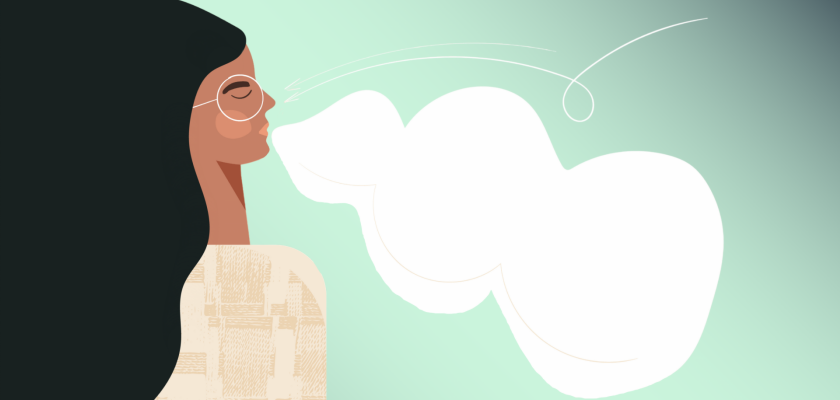The rush of a panic attack can feel completely overwhelming, but there are ways to calm yourself down, even when you’re in the middle of one.
Trying to put a panic attack into words is tricky. The rush of adrenaline and panic – paired with the physical symptoms they produce such as nausea, sweating and shortness of breath – can be a truly overwhelming experience, especially if you don’t have the coping mechanisms to deal with it.
But panic attacks aren’t uncommon. In fact, research suggests 13.2% of people have experienced a panic attack at some point in their lives, with most attacks lasting between five and 20 minutes.
While part of dealing with panic attacks is taking preventative steps, there are also things you can do to help calm yourself down while you’re in the middle of a panic attack. To find out more, we asked Dr Meg Arroll, a psychologist specialising in solution-focussed approaches to health and wellness to share some helpful techniques. Here’s what she had to say.
1. Breathe through your belly
“The most important thing when it comes to panic attacks is to get your breathing back under control,” Dr Arroll says. It’s not only important that you try to slow down your breathing but that you can control where your breath is centred.
“The key thing is to make sure you’re breathing through your diaphragm or your belly,” Dr Arroll explains.
You may also like
F**k, I Think I’m Dying author Claire Eastham on how her first panic attack felt
“Breathing through your chest maintains a sense of panic so place one hand on your chest and one hand on your belly and try to breathe through your belly. It should rise on the inhale and dip back in on the exhale.”
If you’re struggling to centre your breath to your belly, think about breathing through your tailbone, Dr Arroll advises. “Breathe through your nose for a count of three and then out for four,” Dr Arroll says, adding that, “it’s important to breathe out for a little bit longer.”
2. Use a paper bag to help to control your breathing
You may have seen people using a paper bag to help them control their breathing in films or photos and wondered if this was an effective way to manage anxiety. Dr Arroll says that this can, in fact, be a helpful way to control your breathing. “It helps to prevent you from inhaling too much oxygen which will regulate your breathing,” she explains.
“Hyperventilation makes you feel breathless so you might be gasping for air and taking in too much oxygen,” Dr Arroll says, explaining that a paper bag will help to stop this and make you feel less panicked overall.
3. Hold ice in your hand
“Using other senses can help to shock yourself out of a panic attack,” Dr Arroll says, explaining that engaging your different senses can distract your body which might stop your panic attack.
One way of doing this is to put some ice in a tea towel and hold it into your hand. “You can do this until you almost feel some sort of mild pain signal and then move it to the other hand,” Dr Arroll advises.
4. Bite into a lemon

“Biting into something bitter like a lemon is another way to engage your senses which can help to stop your panic attack,” Dr Arroll says.
You could also use another kind of bitter fruit. The key thing is that you get the sensation of biting and the bitter taste in order to engage your senses.
5. Hold onto an object with an unusual texture
“Holding something that feels unusual is a great technique if you’re on the go, as you can easily keep something rough, scratchy or soft in your bag to have ready if you ever have a sudden panic attack,” Dr Arroll says.
“This will engage your sense of touch and help to pull you out of your panic attack,” she continues to explain, adding that you can try different textures to figure out which one is most effective for you.
6. Try a coping visualisation
This method involves you imagining yourself in a situation where you have had a panic attack or you have been in a heightened sense of anxiety in order to stimulate a sense of panic. It’s also known as ‘negative visualisation’.
“While you’re imagining it, walk yourself through how you would cope in that situation. What will happen is that your mind then has a roadmap to follow in terms of dealing with the real panic,” Dr Arroll says.
You may also like
‘Anxious avoidance’ could be making your anxiety worse – here’s how to break free
This technique may sound counter-intuitive but Dr Arroll explains that it works because facing your anxiety head on can often be the best way to deal with it.
“Imagining yourself coping is more useful than trying to avoid the situation,” Dr Arroll says, adding that, “a sense of denial is one of the most detrimental things.”
Frame Of Mind is Stylist’s home for all things mental health and the mind. From expert advice on the small changes you can make to improve your wellbeing to first-person essays and features on topics ranging from autism to antidepressants, we’ll be exploring mental health in all its forms. You can check out the series home page to get started.
If you, or someone you know, is struggling with their mental health or emotional wellbeing, you can find support and resources on the mental health charity Mind’s website and NHS Every Mind Matters or access the NHS’ guide to local mental health helplines and organisations here.
If you are struggling, you can also ask your GP for a referral to NHS Talking Therapies, or you can self-refer.
You can also call the Samaritans in the UK on 116 123 or email [email protected] for confidential support.
Images: Getty
Source: Read Full Article
